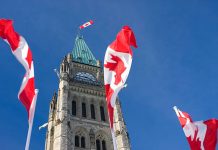Current and expected risks warrant the FOMC holding off on the first cut until September and then carefully assessing lingering inflation risks as each subsequent step is taken. A low of 3.375% is expected for fed funds mid-2026, a modestly contractionary rate.
Following a run of data pointing to inflation being more persistent, the updated views of Chair Powell and the FOMC were eagerly awaited. In the event, the tone of their guidance was balanced, with the FOMC again emphasising they will decide meeting by meeting on the appropriate timing of rate cuts. Very clear in Chair Powell’s remarks though is that they need to see a number of months of good progress on inflation before considering a cut. Given recent momentum, the additional three months of data to come ahead of the July meeting are unlikely to be enough. We now see September as the most probable timing for the first cut, followed by one cut per quarter until June 2026, when we see the fed funds rate troughing at a modestly contractionary 3.375%.
The FOMC is not ignoring the recent momentum in inflation. In the statement, the Committee noted in “recent months, there has been a lack of further progress toward the Committee’s 2 percent inflation objective” and that they do “not expect it will be appropriate to reduce the target range until [they have] gained greater confidence that inflation is moving sustainably toward 2 percent”. However, Chair Powell made clear in the press conference that they still expect inflation will move down over the year. The current stance of policy is deemed “sufficiently restrictive” and the labour market coming into balance. From this guidance and other comments in the press conference, it is evident the Committee is focused on when to cut, not whether.
In gauging the most likely timing of a first cut and the pace thereafter, the persistence of activity and labour market momentum will prove key. Our baseline view is that momentum holds up around trend for activity and above zero for job growth. Wages growth will remain solid with risks skewed upwards. Recall also that most US borrowers are insulated from rate hikes and household wealth is still rising. If our baseline view on the economy plays out, the FOMC are likely to take their time easing policy. The persistence of this economic resilience, and so pricing pressure, also favours our baseline view of a one cut per quarter profile over two years.
Conversely, if the labour market suddenly deteriorates, with employment contracting and the unemployment rate rising materially above 4.0%, then expectations for wages and demand will sour. This would justify an earlier and potentially more rapid policy easing. While this should be seen only as a risk scenario, it cannot be ruled out completely. Business surveys such as the ISMs have, on average, been pointing to net job losses for the past six months.
Jumping ahead and considering our forecast end point for this cycle of 3.375%, two points are worthy of note. First, we do expect FOMC policy to be effective in bringing inflation back around target and so see a material easing over the period, a cumulative 200bps. But second, Westpac continues to see need for restrictive policy into the medium-term, with 3.375% materially above the FOMC’s longer run end point of 2.6%. We expect modestly restrictive policy will be needed into the medium-term because supply-side inflationary pressures evident across the economy, most notably in rents and house construction costs, are likely to persist. Further, with the continuing support to demand from highly expansionary fiscal policy, regardless of which party wins, investment is also likely to be sustained across the economy and with it demand for resources and financial capital.
The latter point is important for both Treasury yields and the US dollar. Over the course of the next two years, we forecast the US 10-year yield will retreat to around 4.0% as inflation declines. But that level is expected, on average, to prove the low point. We see the 10-year yield edging higher during 2026. The result is a swing in the cash/10-year spread from around -80bps to +60bps at end-2025 and rising. Underlying this view is also a belief that, irrespective of which party wins in November’s elections, the US fiscal position is unlikely to improve in coming years and will instead remain at risk of deteriorating further.
For the US dollar, while the extraordinary support from actual and expected rate differentials has abated somewhat in 2024, with the ECB and Bank of England now expected to cut sooner than the FOMC and likely by a similar amount over two years, aid for the US dollar from this factor is expected to remain at or above-average over the period. Around the time of November’s elections, policy expectations should also be constructive for US growth. Consequently, we have flattened out our US dollar profile, seeing DXY only edge lower from the 105–107 range recently traded to 103.5 end-2024 and 99.0 end-2025. Some further weakening is likely in 2026, but it is more probable that the US dollar will remain above long-run average levels than break through.
These developments have implications for Australian financial benchmarks as well. While our own fiscal situation is a stark contrast to the US, this means Australia’s 10-year is likely to trade in line with the US 10-year over the period and into the medium-term, rather than at a premium as in the past. We therefore regard the 4.0% level as a floor for yields in Australia as well, even as policy rates fall. We also continue to expect the Australian dollar to largely track the US dollar, averaging USD0.66 through June and September quarters before beginning to edge higher from December quarter (USD0.67). Through 2025, a 4 cent appreciation is expected to USD0.71 and in 2026 there is reason to believe further modest appreciation will be seen. To this profile, risk appetite and the persistence of inflation are set to remain downside risks. Most of this is a USD story, though; the outlook for Australia’s trade-weighted index remains a continuation of a broadly stable level, as it has been for the past decade.












